July 26, 2019
Air Date: July 26, 2019
FULL SHOW
SEGMENTS
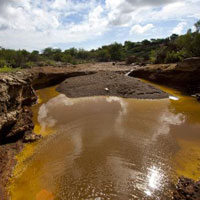
Miners Pollute the Sea of Cortez
View the page for this story
On July 9, 2019, a facility operated by mining company Grupo Mexico spilled thousands of liters of sulfuric acid into the Sea of Cortez. It’s not the first time the company has come under fire for spilling toxic chemicals into the environment: in 2014, 11 million gallons of copper sulfate and heavy minerals spilled from a copper mine it operates in Sonora, contaminating major rivers and creating a local environmental disaster. Kendal Blust, a correspondent for public radio station KJZZ, discusses public outcry over the spill with Host Bobby Bascomb. (07:48)
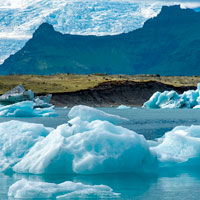
Beyond the Headlines
/ Peter DykstraView the page for this story
In this week’s trip beyond the headlines, Peter Dykstra joins Host Bobby Bascomb to discuss a eulogy for a glacier in Iceland that was lost due to climate change. Next, they turn to the future, or lack thereof, of plastics recycling in the United States. Finally, with a look into the history vaults, the two examine the history of Japan’s controversial whaling for “scientific research”. (04:52)
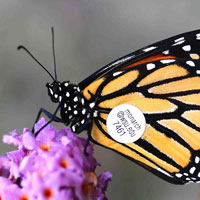
How to Raise Monarchs
View the page for this story
Some people have fond memories of raising monarch caterpillars in their childhood classrooms and homes. But a recent study found that some captive-bred monarch butterflies the US are at a disadvantage when completing their migration to Mexico. Monarch Watch Director Chip Taylor joined Host Bobby Bascomb to share some tips for raising monarchs that won’t be led astray in their migration. (06:08)
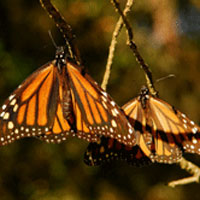
Taggers at Work
/ Rachael McDonaldView the page for this story
Western monarch butterflies migrate, but biologists don't know exactly where they go when they leave the winter warmth of coastal California. Reporter Rachael McDonald spent a day with biologists who are trying to find out. (05:41)
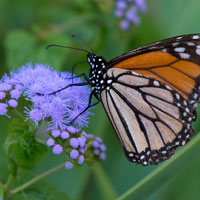
Monarch Migration
/ Mark Seth LenderView the page for this story
On the last standing mulberry tree at Mulberry Point in Connecticut, monarch butterflies gather for the night. Living on Earth's Explorer in Residence, Mark Seth Lender, reflects on the ephemeral lives of these migrating insects. (04:33)
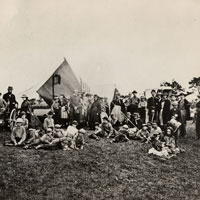
The Value of Summer Camp
View the page for this story
Summer camp for youngsters began in the late 1800s as an escape from urban industrialization. Nowadays traditional summer camps offer a respite from technology and an opportunity to use nature as a classroom. Tom Rosenberg of the American Camp Association talks with Host Bobby Bascomb about the importance of camp in the digital age. (07:35)
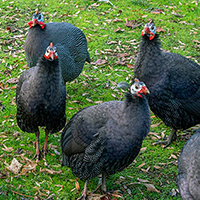
Guinea Fowl and Tick Control
/ Jenni DoeringView the page for this story
Deer ticks can carry Lyme disease, a debilitating disease if left untreated, and one that’s becoming more common thanks to the warming climate. Now some homeowners in the thick of tick country are turning to guinea fowl to control ticks. Living on Earth’s Jenni Doering reports from Exeter, New Hampshire about one family’s experience with these tick-eating machines. (07:52)
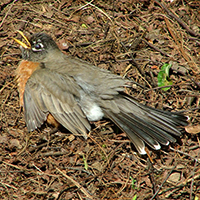
BirdNote®: Do Birds Use Ants as Tools?
/ Michael SteinView the page for this story
Contrary to what the phrase “bird-brained” would have you believe, some birds are far smarter than you might expect. Take the common American Robin, which has learned to use an unusual tool for personal hygiene. BirdNote®’s Michael Stein has more about the behavior known as “anting”. (02:01)
Show Credits and Funders
Show Transcript
HOST: Bobby Bascomb
GUESTS: Kendal Blust, Tom Rosenberg, Chip Taylor
REPORTERS: Jenni Doering, Peter Dykstra, Mark Seth Lender, Rachael McDonald
[THEME]
BASCOMB: From Public Radio International – this is Living On Earth.
[THEME]
BASCOMB: I’m Bobby Bascomb. Tips for raising monarch butterflies that can complete their migration.
TAYLOR: Most of the people doing the backyard rearing are doing this because of something we call monarch rescue, which is the idea that about 98% of all the eggs laid out there never become adult butterflies, and so if you bring them in you’ll be adding to the population. Well, you will, if you do it right.
BASCOMB: Also, using guinea hens to keep ticks at bay and protect children.
KOFF: They were just coming in with ticks every day on them, and my husband was, and I was; and since we've let the guineas go roam around, I haven't seen any ticks on the kids, and my husband I think has found one on himself so far.
BASCOMB: Those stories and more this week on Living on Earth – Stick Around!
[NEWSBREAK MUSIC: Boards Of Canada “Zoetrope” from “In A Beautiful Place Out In The Country” (Warp Records 2000)]
Miners Pollute the Sea of Cortez
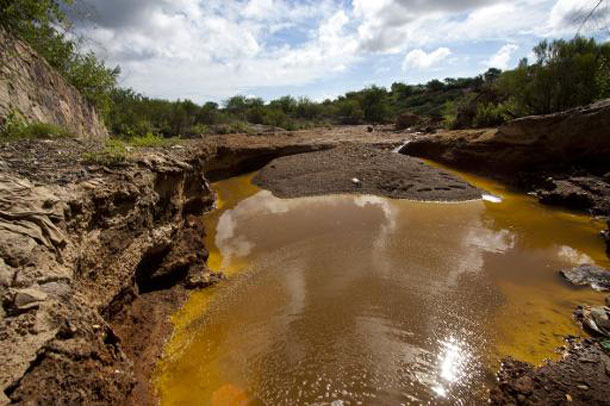
Contaminated water near the Buena Vista copper mine in Cananea, Sonora taken on August 2014. (Picture: Cananean Community, Courtesy of phys.org)
[THEME]
BASCOMB: From PRI and the Jennifer and Ted Stanley Studios at the University of Massachusetts Boston, this is Living on Earth. I’m Bobby Bascomb, in for Steve Curwood.
The Sea of Cortez in Mexico is home to a wide range of endemic marine life, found nowhere else on earth and it’s a critical stopover for rare migrating animals, including humpback whales. Local and commercial fishermen depend on its abundance for their livelihoods. So, a recent spill of sulfuric acid into the Sea of Cortez sent locals to the streets in protest.
[SFX PROTEST]
BASCOMB: The mining company, Grupo Mexico, was responsible for the spill and several other environmental accidents. For more, we turn to Kendal Blust, a reporter for member station KJZZ in Phoenix, Arizona. She joins me now from Hermosillo, Mexico. Kendal, welcome to Living on Earth.
BLUST: Thank you. Thanks so much for having me.
BASCOMB: So, what exactly happened with this recent spill?
BLUST: This spill happened on July 9, there was a failure in a valve between pipes that were transporting sulfuric acid. And they were being loaded on ships there in the port of Guaymas, Sonora, off of the Grupo Mexico facilities, and there was a spill. About 3,000 liters of sulfuric acid spilled into the port of Guaymas in Mexico's Sea of Cortez. And that has caused since then, a lot of concern about what the impacts of that spill are, and what it means about how Grupo Mexico is operating.
BASCOMB: And what are the environmental concerns associated with a spill like this in the Sea of Cortez?
BLUST: There is a lot of concern about it hurting marine life, it hurting the livelihoods of fishermen who work there, people who live by the sea, and the tourism in the area. What researchers are saying, what experts who have tested the water are saying is that there was an immediate impact in the area where the spill happened. There were some dead fish found. But because of the relatively low amount of acid that spilled and the large body of water that it spilled into, it was diluted pretty quickly. And there's little expected consequences to come from this. So, the pH levels of the water, which is the main concern, that they'll become acidic when acid spills, they went back to normal levels within a day or so.
BASCOMB: This is not the first time that Grupo Mexico has come under fire for spilling toxic chemicals into the environment. Can you tell me a bit about the history with this company?
BLUST: Absolutely. This spill itself, of course, has people worried and, you know, seeing a video that came out a couple days later and seeing, you know, white stuff spewing out of these pipes makes people worried. But what is more concerning isn't this specific spill, but sort of the continued pattern. And it's almost five years to the day when a much larger spill happened here in Sonora in August 2014, when about 11 million gallons of copper sulfate acid solution spilled from Grupo Mexico's Buenavista copper mine in Cananea, Sonora. It spilled into the Bacanuchi River, which is a tributary of the Sonora River. Both of those waterways were contaminated. And that's water that serves thousands of people in Sonora. So, that in itself was a huge disaster. And about a month later, there were heavy rains that overflowed dams that swelled the rivers, and that caused agricultural areas near the rivers to be soaked with that contaminated toxic water. So, the impacts of that spill were much greater. People still are feeling the impacts in a lot of ways. It was a really confusing and a really scary time for a lot of residents in the communities around the Rio Sonora. So, this spill, rather than being itself a huge disaster, is a reminder of the disasters that have happened before, and that can happen again.
BASCOMB: And so how did the government respond to that spill? And how did they respond to this more recent one?

The port of Guaymas, Sonora is located next to the Sea of Cortez. (Photo: Intersofia, Wikimedia Commons, Public Domain)
BLUST: Yeah, at the time in 2014, the government's response was a big concern for a lot of people. In the years preceding that spill, they had not been carrying out investigations. And once the spill happened, and they started doing investigations, they found a lot of things that were going wrong at the mine. In this case, both PROFEPA and Mexico's environmental agency, SEMARNAT have been investigating this case since the day after it happened. They've made visits, and in fact, have closed partially those facilities on a temporary basis, because they found that Grupo Mexico did not have the proper environmental authorizations or permits to be carrying out some of its activities at that facility. And so, I think the question for a lot of people is, why are these things found after the fact? Why didn't anyone know that they were operating without the proper permits, before a spill happened? A lot of concern that people have is that the response after the spill in 2014 was inadequate. There were also a lot of broken promises, there were promises of potable water that would be provided that never actually happened. There were promises of medical clinics that would be built to attend to people who were having either acute medical problems from the immediate spill, or having long-term medical issues because of the spill, whether that's things that will show up in the future. Heavy metals can cause cancer, and a lot of people don't know what kinds of contaminants they might have come into contact with. So, that's, I think, where a lot of the distrust comes from. It's both a distrust that companies like Grupo Mexico, these extraction companies, these are large companies, are following the procedures that they should be, that they're looking out for people, but also that if the government is going to hold them accountable.
BASCOMB: So, people have that on their mind now, during this current spill, and are pretty upset from what I gather.
BLUST: Absolutely, there's a distrust that there's anybody looking out for them. And because of that, a lot of people at protests and, you know, coming on to news media here are saying that they want to see Grupo Mexico completely expelled. They want their concessions here in Mexico, not just in Sonora, in Mexico to be revoked. And one woman I spoke with yesterday about the closure of the facilities said that that's just not enough. It's not enough for her. And it's not enough for a lot of protesters and a lot of people who are concerned about their communities to close one facility on a temporary basis. They want to see that this kind of thing won't happen again.
And the President has said that Grupo Mexico won't have any special offers, they won't get any special deals and that they're going to hold them accountable. But he's also said he wants to hear from Grupo Mexico, he wants to know all the facts. And they need to protect jobs that are created by Grupo Mexico's mines and other operations. So, I think it's a very open question of what will happen. I think asking for Grupo Mexico's concessions to be completely revoked -- it's a big ask, and I think we don't know yet what's going to happen. But it's certainly a question both on the minds of local residents and clearly on the minds of government officials.
BASCOMB: Kendal Blust is a reporter with the NPR member station KJZZ. Kendall, thank you so much for taking this time with me.
BLUST: Thank you, Bobby.
Related links:
- Fronteras | “Sonorans Protest Against Mining Companies After Sulfuric Acid Spill”
- TUCSON.COM | “Sonoran River Mine Spill Threatens Mexican Communities”
- New Internationalist | “Mexico’s Worst Environmental Disaster in Modern Times”
- Greenpeace | “Toxic Spill in Sonora The Tip of the Iceberg”
[MUSIC: Jacob Collier, “I Heard You Singing (feat. Becca Stevens & Chris Thile)” on Djesse Vol. 2, Hajanga Records]
Beyond the Headlines

Okjokull Glacier in Iceland is suspected to be the first of many glaciers to disappear. (Photo: Al Case, Flickr, CC BY-SA 2.0)
BASCOMB: It's time for a trip now beyond the headlines with Peter Dykstra. Peter's an editor with Environmental Health News, that's ehn.org, and daily climate.org. Hey there, Peter, what do you have for us this week?
DYKSTRA: Hi, Bobby. We're going to start with a requiem for a glacier.
BASCOMB: Oh?
DYKSTRA: In Iceland, there's a glacier called Okjokull, better known as OK, that is the first at least in Iceland, maybe the first anywhere, to completely vanish due to climate change. Scientists that have studied the demise of the glacier are going to lay a plaque with a eulogy. It will be unveiled next month as we go toward the highest melting period in places like Iceland and the High Arctic, and the plaque is kind of touching.
BASCOMB: And, what does the plaque say?
DYKSTRA: Here's the word for word. “OK is the first Icelandic glacier to lose its status as a glacier. In the next 200 years, all of our glaciers are expected to follow the same path. This monument is to acknowledge that we know what is happening and what needs to be done. Only you know if we did it.” The “you” being the people of the future.
BASCOMB: Wow. So, it's really placing the responsibility squarely on our own shoulders today.
DYKSTRA: It is, maybe more than we're taking it on ourselves. But we'll see.
BASCOMB: And, what else do you have for us this week, Peter?
DYKSTRA: Well there was an item that was reported on by one of our favorite investigators, Sharon Lerner, who writes for the Intercept website. She did a piece on the plastics industry going whole hog into the greenwashing phenomenon. And, recently as plastics have come under fire, the plastics industry has freaked out a little bit.
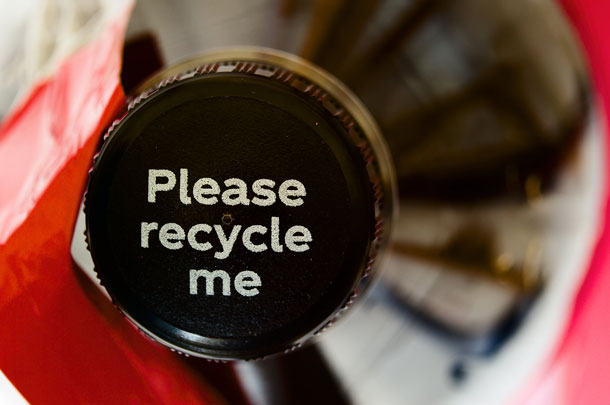
Although the system of plastic recycling in the United States is failing, many cities and states continue to collect recycling to maintain the habit of recycling with their citizens. (Photo: Filip Patock, Flickr, CC BY-SA 2.0)
BASCOMB: Yeah, I mean, cities across the country are looking into banning plastic bags and straws and single use plastics. How is the plastic industry responding?
DYKSTRA: One of the things that they're doing is a school education campaign about the wonders of plastics recycling. Despite what they're telling the school kids, recycling is turning out to be a very, very disappointing solution.
BASCOMB: Mhm. Yeah, that's for sure. I mean, the US, I think, at best used to recycle about 9% of its plastic and since China's stopped taking our recycling, that number has gone down to practically zero, I think. So, it's a really a huge problem.
DYKSTRA: And, now in the US, instead of shipping it overseas, we're now landfilling plastic instead of recycling it. And we now burn six times the amount of plastic that we actually recycle in this country. And the Trump Administration has taken notice, but not in the way we might think. There's a new sales item for the Trump 2020 campaign. They're selling packs of plastic straws that perform better than those, quote, "liberal paper straws." 10 straws for 15 bucks in kind of a cynical response to the actions against plastics.
BASCOMB: Oh, man. Do you think that President Trump just had enough with the paper straws himself? Or is this really just a thumb in the eye to environmentalists who care about plastic straws in the environment?
DYKSTRA: We can't say this weighty policy issue made its way all the way up to Trump, but it certainly was an opportunity for somebody in the Trump regime to take a poke at an environmental initiative.
BASCOMB: Well, what do you have for us from the history vaults this week?
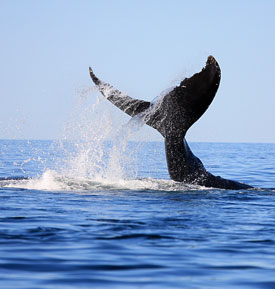
Whaling continues today despite the massive population decreases among most species of whales. (Photo: Cyrille Humbbert, Flickr, CC BY-SA 2.0)
DYKSTRA: Going back to a year after the end of World War II, General Douglas MacArthur, widely hailed as the victor of the Pacific War, is now the military governor of Japan. And, in one of the measures he takes to try and jumpstart the Japanese economy ruined by the war is that he takes two Japanese tanker ships and orders them converted into whaling factory ships, thereby restarting a dead industry in Japan, the whaling industry. Over the next two decades, it grows and prospers to the point where by the 1960s, there's huge controversy over the fact that Japan's whaling industry is leading the planet's largest animals into extinction.
BASCOMB: But don't they claim that the whaling industry there is really about doing scientific research?
DYKSTRA: When commercial whaling was finally banned in the 1980s, Japan used a clause in the international agreement that allows them to continue whaling for “scientific research” purposes. And even though it's on a much lower scale, they take the same whale meat, sell it in the same whale meat markets in Tokyo and other cities. And they say it's all being done for the sake of scientific research. Whaling for scientific research is science the same way that professional wrestling is a sport.
BASCOMB: [LAUGHS] Yeah, seems a little suspect, huh?
DYKSTRA: Yeah.
BASCOMB: Peter Dykstra is an editor with Environmental Health News, that's ehn.org, and dailyclimate.org. Thanks, Peter. We'll talk to you again real soon.
DYKSTRA: All right, Bobby, thanks a lot. Talk to you soon.
BASCOMB: And there's more on these stories on our website, LOE.org.
Related links:
- NYTimes | “Scientists honor Iceland's first glacier lost to climate change with plaque, eulogy”
- The Intercept | “How the Plastics Industry Is Fighting to Keep Polluting the World”
- Wired | “The Japanese barely eat whale meat so why do they keep whaling?”
[MUSIC: Gov't Mule, “Child Of The Earth” on High & Mighty, composed by Warren Hayned, ATO Records]
BASCOMB: Coming up – Tips for raising monarch butterflies this summer. That’s just ahead on Living on Earth.
ANNOUNCER: Support for Living on Earth comes from Sailors for the Sea and Oceana. Helping boaters race clean, sail green and protect the seas they love. More information at sailors for the sea dot org.
[CUTAWAY MUSIC: Arturo Sandoval , “Blues En Fa” on My Passion For The Piano, Written By Arturo Sandova, Columbia]
How to Raise Monarchs
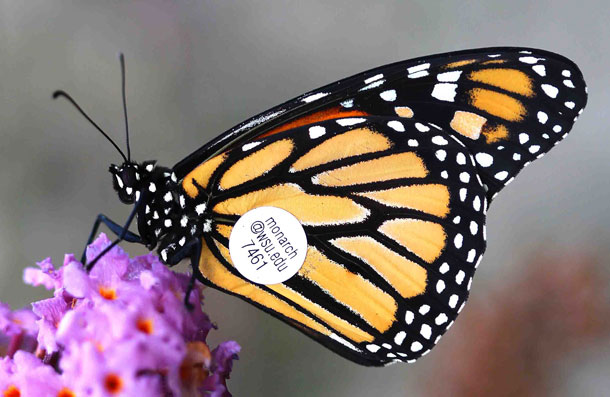
To keep track of Monarch Butterflies’ migratory paths, groups like the Monarch Watch tag the butterflies. (Photo: USFWS - Pacific Region, Flickr, CC BY-NC 2.0)
BASCOMB: It’s Living on Earth, I’m Bobby Bascomb.
Each spring, Eastern monarch butterflies wake up in the mountains of Mexico and make their migration to warmer climates, like Texas, where they breed and die. The Texas monarchs travel a few hundred miles further north, where they also breed and die. It takes four or five generations of monarchs to reach the northern end of its range, perhaps as far north as Canada, where a super generation is born that will fly all the way back to the same mountain in Mexico where its great, great, great grandparent started the journey. Scientists don’t understand how the monarch completes its incredible voyage, but a new study has found some well-meaning butterfly enthusiasts may be hampering it. That study from the University of Chicago finds that captive-bred monarchs are not as likely to complete that return migration to Mexico. Here to tell us more is Chip Taylor, Director of Monarch Watch. He says the study should really be used to inform us about the best way to raise monarchs at home.
TAYLOR: So, the general takeaway message that many people have had from this paper is that reared butterflies don't migrate. And, that's simply not true. What you do have to do to get monarchs that migrate is rear them under the right conditions. And, that's something that has not been standardized. Many people are rearing them under conditions that are not entirely satisfactory, and the reared butterflies tend to be a little bit smaller. So, their possibility of getting to Mexico is a little bit reduced. And, a lot of the butterflies that are reared, are reared in parts of the US where the probability of getting to Mexico is actually reduced as well, simply due to the distance. So, the reared butterflies don't get to Mexico as well as the wild ones do, but they still get there.
BASCOMB: So, is the take home message here, then, if somebody is interested in raising caterpillars in their own home, don't buy them online from one of these breeders, but go out and look in your yard and your neighborhood?
TAYLOR: Most of the people that are doing the backyard rearing are rearing monarchs that they find in their backyard. Or they're scouring the landscape to find eggs, and they're going to parks, and they're going to natural areas and finding eggs and bringing them in. And the reason they're doing this is they're invested in something we call monarch rescue, which is the idea that about 98% of all of the eggs laid out there never become an adult butterflies. And, you know, they're subject to all sorts of predation, and parasitism, and so on and so forth. And so, if you bring them in, you'll be adding to the population. Well, you will, if you do it right. But, if you don't do it right, you're not going to be adding to the population. And so, what we're trying to do is encourage people to do the right thing. Rear these butterflies in the way that they have some prospect of not only getting to Mexico, but surviving the winter, and surviving the trip back north to Texas, and surviving to reproduce.
BASCOMB: And, so, what are the things that people should be doing if you're going to raise them in your home?
TAYLOR: What we really advise people to do is raise them on naturally occurring plants or plants in pots. To rear them with their normal day-night exposure. To rear with normal photoperiod exposure; to do this, and to do it well so the butterflies achieve maximum size. And also, tag them and release them at the right time, which is at the beginning of the migration. So, it's relatively simple, if you're gonna do it in a school or in a kitchen or something like that, expose them to natural light. But hopefully keep them in a place where they can experience day-night temperature variation as well.
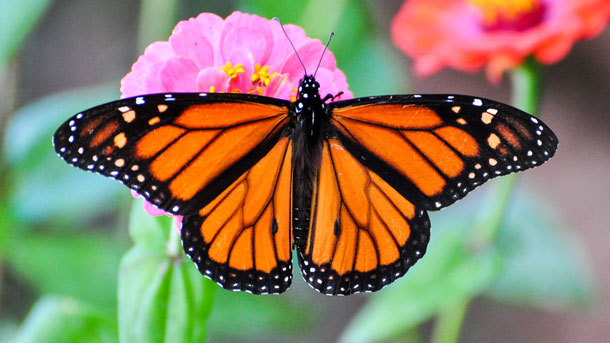
A monarch butterfly. (Photo: Peter Miller, Flickr, CC BY-NC-ND 2.0)
BASCOMB: Would the ideal scenario be to put them in a jar or a net or something on a porch, maybe a screened-in porch or something where they're getting the day and the night and the temperature changes?
TAYLOR: That would be a good way to do it. And probably not in a jar, but everything from an aquarium to a cage. And you can use cut leaves or live plants. But, if you're going to use cut leaves, they've got to be really fresh, and you've got to change out the leaves, you know, and keep the containers clean, and so on and so forth. This is not a hard thing to do. And it's kind of fun to do. I've been doing it since I've been a kid. [LAUGH] I've really been doing this for a very long time. It's a very enjoyable activity. We don't want to discourage people from doing it. But we'd like to have people do it in the best possible way.
BASCOMB: I have to admit; I have ulterior motives for asking you all these specific questions. I raised them last year in my home with my daughter, just for her to have that experience of seeing how they change and grow, and talk about the metamorphosis and the science behind it. If I want to do that again this year and tag them, how would I go about doing that? How does the average person know how to tag a butterfly? Seems like a very, I don't know, fine skill? [LAUGHS]
TAYLOR: [LAUGHS] Well, we have instructions on our website, we have a tagging program we've been running since 1992. Monarchs are pretty sturdy butterflies, and we teach people to put the tag on the discal cell, which is a large palm-shaped cell on the underside of the hind wing. It's a tag that weighs about a fiftieth of the mass of the butterfly. And, every tag has a different code. And we take that information, and we enter it into a database. And then when there is a recovery, we can trace back to who tagged that particular butterfly. But furthermore, when you send in your data sheet, we can use all of the data for every tagged butterfly as a way of tracking this migration, to see whether migration is early, whether it's late, and so on and so forth. And by putting all that information together, we can take a look at whether butterflies tagged in Massachusetts have the same possibility of getting to Mexico as, say, the butterflies tagged in Buffalo, New York.
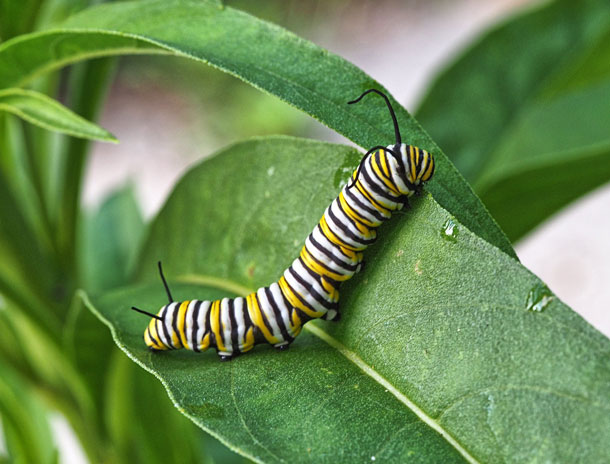
The preferred food of Monarch caterpillars is native milkweed. (Photo: John Brandauer, Flickr, CC BY-NC-ND 2.0)
BASCOMB: And, before you go, why do you do this work? Why have you dedicated your life to monarchs as opposed to doing any number of other things you could have done? Why are monarchs important for anyone?
TAYLOR: The quickest answer is to save the planet. [LAUGHS] We have to save this planet. And with regard to monarch butterflies, it's connecting people with things they value. That's an important thing. And monarch butterflies are valued by a lot of people. They're recognized as a symbolic organism that tells us a lot about what's happening in the environment. And, you know, if we can connect with something that's of value that will probably be lost, then maybe we can get people's attention.
BASCOMB: Chip Taylor is Director of the Monarch Watch. Chip, thanks for taking the time with me.
TAYLOR: Well, thank you! Appreciated being on.
Related links:
- Monarch Watch’s guide to tagging and rearing monarch butterflies
- Click here to read a study on non-migrating monarchs
[MUSIC: Herbie Hancock, “Butterfly” on Thrust, Written by Herbie Hancock, Columbia]
Taggers at Work
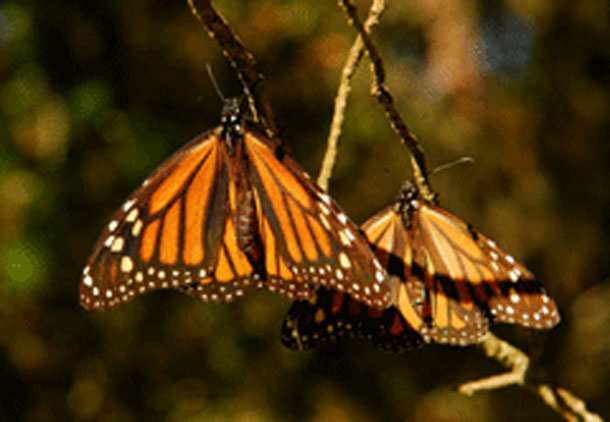
Monarchs (Photo: Tom Moss, CA State Parks)
BASCOMB: The vast majority of Eastern monarchs spend the winter in the Sierra Madre Mountains of Mexico. But western monarchs, those that migrate west of the Rocky Mountains, overwinter on the coast of California and fan out from there across the West each summer. The problem is, wildlife biologists don’t know precisely where all those butterflies go, so they don’t know which places to protect. To figure that out, some Western monarchs are being captured and tagged, so biologists can track them. But how do you tag the delicate wings of a butterfly? Very carefully, as reporter Rachael McDonald found in 2007 when she tagged along with biologists in the town of Pacific Grove, on Monterey Bay.
McDONALD: Pacific Grove's George Washington Park is a shady grove of trees on the edge of a quiet residential street. Here, on a cool late winter morning, wildlife biologist Jessica Griffiths is reaching high into a live oak tree with a 15-foot pole with a net on the end. She's shaking the pole.
GRIFFITHS: Okay. So, you can see they're really cold, they’re not moving very much.
McDONALD: The monarchs are all clustered together at the end of a branch.
[SHAKING SOUND]
GRIFFITHS: Rise and shine!
McDONALD: Griffiths shakes the butterflies into the net and then lowers it, and with the help of a volunteer, carefully pours the insects into a paper bag.
[MONARCHS GO INTO THE BAG]
McDONALD: Griffiths instructs the six volunteers helping her tag monarchs today. They're sitting on folding chairs in the middle of the forest. Each pair has a bag full of untagged butterflies and another bag for tagged ones.
OLSEN: Female.
McDONALD: One at a time, intern Jen Olsen takes a butterfly out of the bag, identifies it as male or female, then gently attaches a tiny fingertip-sized sticker to the underside of its wing. She's careful not to touch the top part of the wings where delicate, brightly colored scales could be rubbed off. Another volunteer notes the insect's gender on a data sheet.
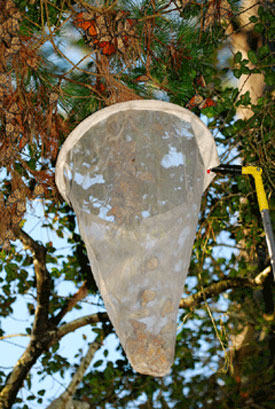
Monarchs are captured using a net on a pole that extends 25 feet up to where the butterflies are hanging. (Photo: Tom Moss, CA State Parks)
This is a pilot program of the Ventana Wildlife Society, a local non-profit funded by donations and grants. Biologist Jessica Griffiths says the goal is to understand two things about the monarchs that come here. One, where do the butterflies go during the winter?
GRIFFITHS: Butterflies come to specific places on the California coast to spend the winter and we have actually long suspected that they probably move around during the winter between over-wintering sites; however, that's very hard to tell when the butterflies are not marked in any way because all the butterflies look the same.
McDONALD: Each tag has a toll-free number and a tracking number for the particular butterfly. Several months ago, Griffiths' team tagged about a thousand butterflies. A few weeks later she got a call from someone who found a tagged one up north near Santa Cruz. Another was found in Big Sur, more than 40 miles south of here.
GRIFFITHS: Just that data alone made the tagging worthwhile because we really didn't have any idea that they could move so far so quickly.
McDONALD: Griffiths hopes this information helps conserve western monarch habitat up and down the central coast. That habitat is disappearing.
GRIFFITHS: We can't just, you know, protect, for example, the monarch sanctuary in Pacific Grove and think, well that's one spot, that's enough for them. We need to try and conserve as much habitat as we can.
McDONALD: Then, she says, once the monarchs leave for the spring and summer months, she hopes the tags will show her exactly where they go.
GRIFFITHS: What they do is they're going to all mate together in sort of a big frenzy, and then they leave the central coast and then they disperse inland in order to find milkweed, which is their host plant. But we don't know exactly where the butterflies from Pacific Grove go. Do they mostly go north or south or -- where do they go?
McDONALD: The Ventana Wildlife Society had to get special permission from the city council to tag the butterflies. A local ordinance makes it illegal to touch or bother a monarch butterfly. Anyone who does so gets fined a thousand dollars. Once a bag full of monarchs is tagged, they can be released. The team puts bags of butterflies in the sun on folding chairs so they can warm up.
[BUTTERFLIES MOVING IN THE BAG]
McDONALD: The butterflies are fluttering their wings. Nelly Thorngate, another wildlife biologist with Ventana says when the monarchs warm up, their circulation starts up.
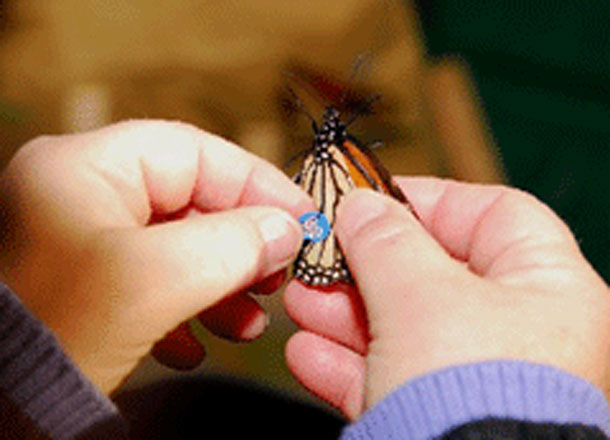
This small sticker is placed on the monarch’s wing. (Photo: Tom Moss, CA State Parks)
THORNGATE: You can see them do this in the trees too, at about this time when the sun starts to hit the trees, they'll open up in their clusters and start to shiver as a bunch. What's neat is that they seem to hit a critical mass like that where they'll all shiver and kind of open their wings and be hanging out, and then all of a sudden everyone will take off at once, and it's amazing to see.
McDONALD: But here Thorngate and Griffiths let the insects go, one at a time.
GRIFFITHS: Would you like to release one?
McDONALD: Griffiths addresses a young volunteer, a little girl with her father, helping.
GRIFFITHS: Okay, so what you're going to do is you're going to hold him. I'm going to pass him to you and you're going to hold him with the wings closed and you're going to go like this, and when your hand is up high, that's when you're going to let him go, okay? There you go!
McDONALD: And the monarch takes off.
GRIFFITHS: [LAUGHS] Whoa, let's see if he can do it. All right, there he goes!
McDONALD: They’ll follow the milkweed, fanning out across the West.
BASCOMB: That report from Rachael McDonald came to us courtesy of KAZU in Monterey, California.
Related link:
Ventana Wildlife Society
[MUSIC: The Beatles “Flying” on Magical Mystery Tour, Written By: Harrison, Lennon, McCartney, Starr, Capitol Records]
Monarch Migration
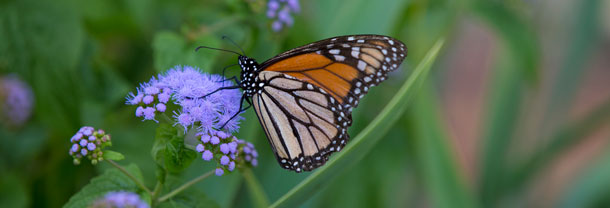
A monarch perches on a purple flower. (Photo: Mark Seth Lender)
BASCOMB: Well, tagging monarchs and calling in when you find a tagged butterfly is one way to help the iconic species. Another is to plant a pollinator garden and be sure to include native milkweed, the only plant monarchs will lay their eggs on. As Mark Seth Lender, our Explorer in Residence explains, a garden planted with the right intentions, even one no bigger than a couple of parking spaces, can make all the difference in the world.
Monarch Migration
Monarch Butterfly
Guilford, Connecticut
© 2019 Mark Seth Lender
All Rights Reserved
On a mulberry tree, the last one standing on Mulberry Point, Monarchs have gathered for the night. They rest, like a living coat flexing their magnificent arms sleeved in wings; their eyes cache the fading light the way a stamen might hold a drop of rain fallen on the flower. They face the sunrise side, waving their bedtime prayers in hope, and anticipation.
Praying for the sun to rise.
In a cloudless sky.
And the warmth of the morning light that will be their salvation!
They are in migration, a flight of many parts that will end, with the end, of their lives.
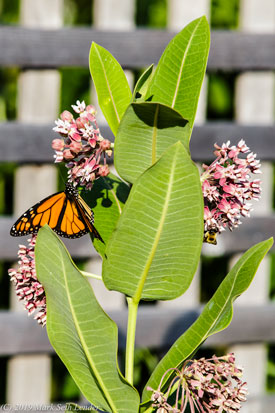
Monarchs will only lay their eggs on milkweed plants. (Photo: Mark Seth Lender)
In the day, these very same butterflies were in the garden Valerie planted for us for our joy. They drank wild daisies and verbena, cone flower and sage and wild bergamot and in concession to the unfamiliar weathers come now to our latitude, from three small buddleia we planted just for them, the deep blue-violet flowers sweet with perfume, spreading out against the white painted wall of the shed, serving the purposes of necessity and a need that is dire.
For the Monarchs are fading; fading as the light fades on their translucent, outlined, pennant forms. I saw more than one lay her eggs, opal white, small as the smallest sand grain.
I watched.
I watched.
None, not a single one, became the black-yellow-white warning colors of the caterpillar; I found no chrysalides under the milkweed leaves.
I saw no gold and orange Monarch Butterflies emerge.
As the season collapsed into itself like a cat curling into a long sleep, we found the last Monarch of the year, her wings too cold to lift her off the roadway. We placed her in shelter in among the roses of a nearby garden. On the way, back from our walk down the shoreline, we found her where we left her, fast asleep. And in the morning, gone. We saved her. Though it was late.
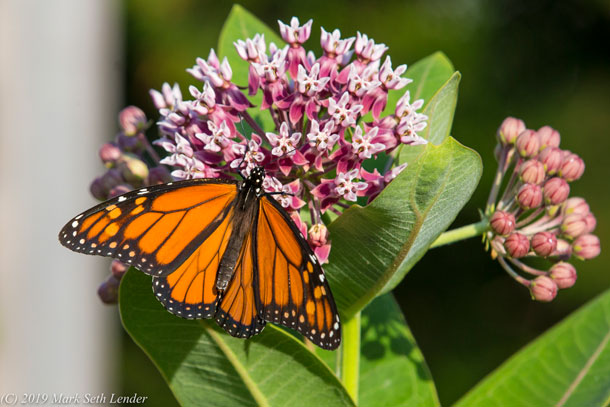
Since milkweed will attract Monarchs, the plant is often used in butterfly gardening. (Photo: Mark Seth Lender)
Too late for her to pass life on.
To the next generation.
To continue the journey.
Generation by generation to its conclusion an ending she was never intended, to see.
But I saw the tree! The mulberry and its Living Leaves! Perhaps, somewhere on the way, perhaps where some other Monarch Butterflies laid their eggs and died, perhaps their progeny, and their progeny, still live.
They give everything away, in gift to the Future, to those they will never know and who will never know their names.
It gives us hope.
BASCOMB: That’s Living on Earth’s Explorer in Residence, Mark Seth Lender. To see some of Mark’s monarch photos check out our website, loe.org.
Related link:
Mark Seth Lender’s website
[MUSIC: Herbie Hancock, “Butterfly” on Thrust, Written by Herbie Hancock, Columbia]
BASCOMB: Coming up – Summer camp! Why it’s important for children to spend time in nature and how to make it more accessible. That’s just ahead on Living on Earth.
ANNOUNCER: Funding for Living on Earth comes from you, our listeners, and United Technologies, combining passion for science with engineering to create solutions designed for sustainability in aerospace, building industries, and food refrigeration. UTC companies such as Otis, Carrier, Pratt and Whitney, and UTC Aerospace systems are helping to move the world forward. You can learn more about United Technologies by tuning into the Race to Nine Billion podcast; listen at racetoninebillion.com. This is PRI, Public Radio International.
[CUTAWAY MUSIC: Snarky Puppy, Metropole Orkest, “The Curtain” on Sylva, Written By – Michael League, Impulse!]
The Value of Summer Camp
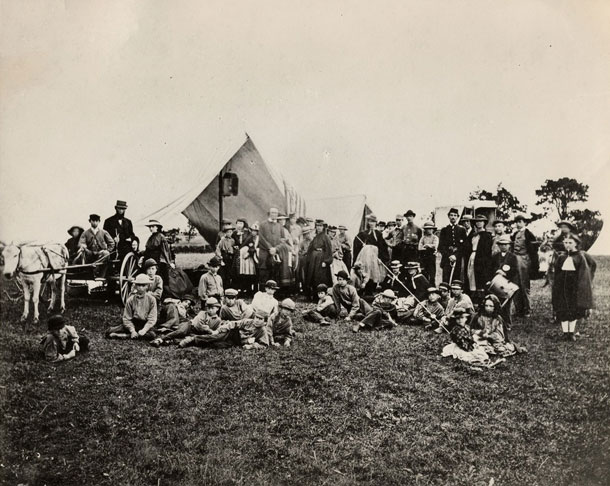
Gunnery Camp, considered to be the first organized American summer camp. (Photo: Wikimedia Commons, Public Domain)
BASCOMB: It’s Living on Earth, I’m Bobby Bascomb. Summer camp is a longstanding tradition in the United States. It’s a way for kids to take a break from academics and connect with nature. Today, there are thousands of camps across the United States, from day camps to specialty sleep-away camps. Activities range from the traditional canoeing and archery to building robots or painting birds. Here to tell us more about summer camp and the role it plays in the lives of children is Tom Rosenberg, President and CEO of the American Camp Association. Tom, welcome to Living on Earth!
ROSENBERG: Thanks, Bobby! It's a thrill to be with you.
BASCOMB: So, summer camp in the United States has a pretty long history, from what I understand. Can you tell me a little bit about that? When did summer camp get started here?
ROSENBERG: Camp really has been around for probably over 150 years. The early camp directors were, in fact, teachers who were bringing their young people, their students out to the woods to escape urban industrialization and distraction, and bring them to a healthier environment in which to focus and learn, using nature as a classroom. Many of America's camps are over 100 years old, but there are camps for children with medical disorders, there are camps for children of a particular culture or faith. There are also camps that are very diverse and secular and focused on a particular activity, for example, like kayaking, or rock climbing or, or academics for that matter.
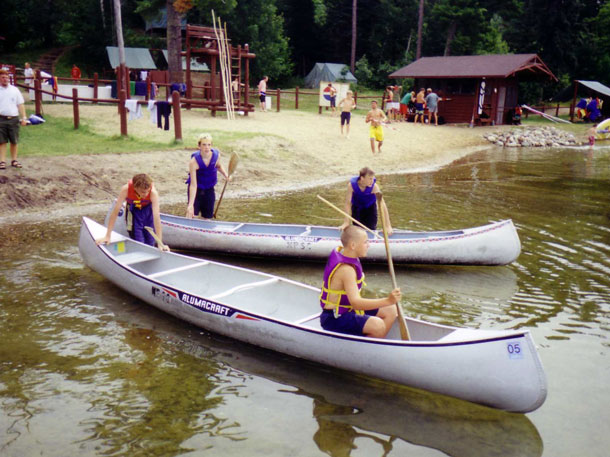
Summer campers launching canoes. (Photo: Steve B, Flickr, CC BY-NC 2.0)
BASCOMB: Yeah, it seems there's a rise in recent years in more specialized camps like computer camp or soccer camp, band camp, engineering camp, I mean, you name it, it seems there's a camp for that. What do you see as the benefit of those camps as compared to a more traditional, you know, canoeing type camp?
ROSENBERG: You know, I have visited camps that are based in nature, and that are teaching science and engineering and robots and physics, actually at an outdoor summer camp. I think parents today are looking for their children to learn new skills in an environment that has a little bit of that traditional piece there. So it has exposure to nature, that also offers them that community experience where they're learning to live and work and play and appreciate nature in a group setting. So they're learning to build relationship skills, learning to be more independent away from mom and dad, but also learning to be responsible for the group and for nature, and some stewardship skills.
BASCOMB: Tell me about family camps, those are camps that the whole family can attend together.
ROSENBERG: Absolutely. Family camp is not a new concept. But it's a growing concept where overnight camps have accommodations for the whole family to go. So, when I was a camp director, we would have sometimes three generations of a family come and experience overnight camp together for solid a week sometimes. And at family camp, kids can be engaged in programming that is appropriate for kids, teens can be engaged in teen programming, adults can do adult level positive risk opportunities. And, so, at different times of the day, the whole family's together doing activity. Some family camps, you can even decide which meals to enjoy camp-style with your counselors and which meals to enjoy with your parents. So, it's a great way for everyone to get in the fun, everyone to experience nature.
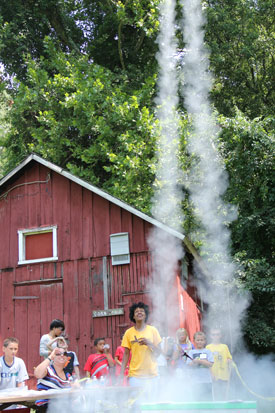
Campers launch rockets at a math and science specialty camp. (Photo: CERDEC, Flickr, CC BY-NC 2.0)
BASCOMB: What role do you think camp plays in childhood development more generally? I mean, why send your kid away to camp to learn how to canoe and get devoured by mosquitoes?
ROSENBERG: [LAUGHS] Well, I would tell you that today camp is a more essential educational experience for children, teens, and young adults than ever before. There are studies that are pointing to this generation of post millennials being very digital. And, they're developing the majority of their relationships digitally, and they're communicating primarily in a digital fashion. So, where is this generation learning in-person social skills? Where are they learning intuition and empathy for each other? We need to make sure that our children have a grounded education in social and emotional learning. And, tied to that we need to take advantage of nature's classroom, because kids have the opportunity at camp to have distraction-free learning. I think you probably know that kids today with ADHD, for example, are better able to concentrate after being in nature. And so camp is very therapeutic. We know that from scientific studies that exposure to natural environments improves a child's cognitive abilities by improving their awareness, their reasoning and their observational skills. I also think that kids today are over scheduled, and perhaps overstressed. Kids are showing up at camp today with a considerable amount of trauma from different sources back at home, not necessarily in their home, but just trauma. And so camp is therapeutic. Nature is therapeutic.
BASCOMB: And, what about just creating a relationship with nature?
ROSENBERG: Absolutely. It's so important, Bobby, to give children an opportunity to create their own personal relationship with nature, to develop an understanding of what it means to be an environmental steward, to take responsibility for our world and to understand the cause and effect relationship between humans and nature. All American children, regardless of whether they've been to camp before or not, need to have these kinds of experiences outside so that they can develop an appreciation for our natural resources.
BASCOMB: Talk to me a bit, please, about the socioeconomic breakdown of campers today. What does the average camper look like? And, how are you trying to make that more available to everyone?
ROSENBERG: The average cost of a week-long day camp ranges from $100 to over $500 for a week; the cost of an overnight experience, that price can vary from under $200 for a highly subsidized camp to over $1500 a week in a very expensive setting. 93% of American Camp Association accredited camps offer some form of scholarship. But it does take a good bit of work on a parent's part to find a camp that offers the resources or resources that help them get to the camp of their choice. We are trying to make camp more accessible. I'd say today in American Camp Association accredited camps, over 30% of campers and seasonal staff are from a diverse background, but we're working every day to make more parents aware of camp and the benefits it offers their children, as well as ways to make it a more equitable experience for all.

Marshmallows roasting over a campfire (Photo: Josh Cambell, Unsplash, Public Domain)
BASCOMB: Do you yourself have any favorite camp experience that you look back on fondly - well, that was the moment that I decided I was gonna, you know, dedicate my life to camp.
ROSENBERG: I had many wonderful experiences as a camper in camp. But probably my most favorite memorable experience out in nature was I had the opportunity to spend my summer leading first-time backpacking trips for boys and girls into the Appalachian Mountains. And, there is nothing like showing the wonder and rigor and challenge of backpacking to, you know, tweens who are doing it for the first time. There's nothing like that. That experience really reinforced for me why I wanted to lead camps, so that I could help generations of kids embrace nature and embrace community and embrace learning outside. Camp is such an inspiring experience in different ways for different people. So, it has been and always will be that place that I go to, to become re-centered. To be more mindful, take a deep breath and think about how I think about what inspires me about today and tomorrow.
BASCOMB: Tom Rosenberg is the President and CEO of the American Camp Association. Tom, thanks so much for taking this time with me.
ROSENBERG: Thanks for having me, Bobby. I've really enjoyed this.
Related links:
- About the American Camp Association
- OutsideOnline | “We Need Camp More than Ever Before”
[MUSIC: Chet Baker, “Summertime” on Chet Baker Quartet, Written By Heywood, Gershwin, Barclay]
Guinea Fowl and Tick Control
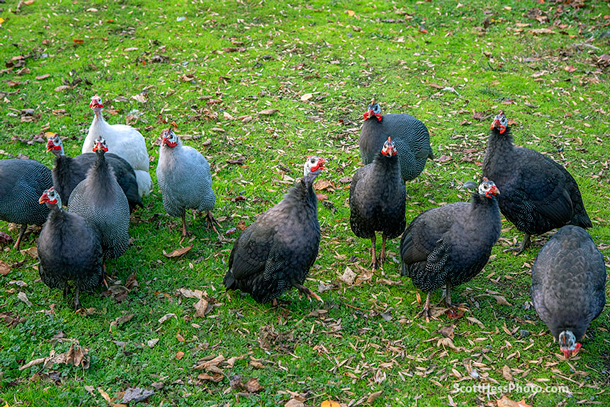
Guinea fowl like to forage for ticks, mosquitoes, fleas, beetles, spiders, and more. (Photo: Scott Hess, Flickr, CC BY-NC 2.0)
BASCOMB: It’s the height of tick season, which means if you spend any time in the woods, you might become a meal for the tiny blood-suckers. And if you’re in the eastern U.S., beware of the blacklegged or deer tick, which can carry Lyme disease. If left untreated, Lyme can spread to the joints, the heart, and the nervous system. More than 40,000 new cases of Lyme were reported in 2017, and climate change could make it even more common. A recent study found that a temperature increase of just 2 degrees Celsius could result in a 20 percent increase in Lyme disease cases in the U.S. Luckily, there are proven ways to reduce your risk of getting Lyme disease: wear long sleeved clothing, use repellents, and do a thorough tick check after you’ve been in the woods. And for those who share a backyard with tick-infested woods there are other, more unconventional ways, to protect your family. Living on Earth’s Jenni Doering reports from Exeter, New Hampshire.
[FOREST SOUNDS]
DOERING: Suzy and Hazel Koff live an enchanted childhood.
On a warm July day the 6 and 3 year olds run through the sun-dappled forest in their New Hampshire backyard.
[SOUNDS OF KIDS RUNNING AND PLAYING]
SUZY: Okay, come out!... No, no, no, no, no!
DOERING: Their mother, Sarah, says this is how they spend their summer.
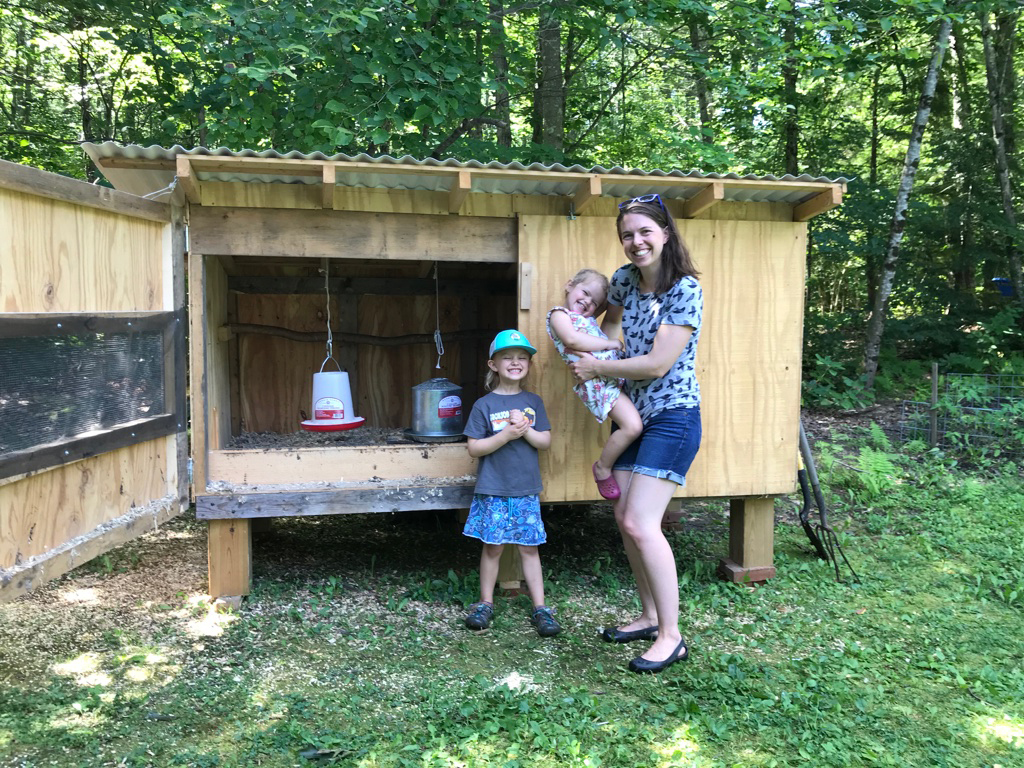
Sarah Koff with daughters Suzy, 6, and Hazel, 3, in front of the guinea fowl coop in their backyard. (Photo: Jenni Doering)
KOFF: We love going outside playing in the woods. We have this great big yard that they play in and we have a sandbox out here and slack line and all sorts of things; we like to make fairy houses, and we like to garden together. So, yeah we’re outside pretty much every day.
DOERING: But in the Northeast, where there are woods, there are ticks. A lot of them.
KOFF: I was so, just, overwhelmed by the ticks in our yard. I’m a big gardener and my daughters – I just feel like it’s really important for them to spend as much of their time outside as possible. And you know, we live in the woods. And so in April and May, they were just coming in with ticks every day on them – and my husband was and I was – and it was just getting too much; I was so overwhelmed and I just, I’m such a big gardener, there’s no way I was willing to spray anything on the lawn or use any sort of chemicals at all, so I thought I would try this biological control…
DOERING: Enter the guinea fowl --
[GUINEA FOWL CALLING]
DOERING: Native to Africa, guineas are rather awkward, football-shaped birds with a tiny head, and a voracious appetite for ticks. And unlike chickens, guinea fowl won’t peck at your garden greens. So Sarah decided to give them a try.
KOFF: Yeah, I just went on Craigslist and I pretty easily found… there were actually a lot of different ads for people selling guineas but we wanted a certain amount and we wanted them to be babies, so it was a perfect guy who had them and raised them and told me a lot about them.
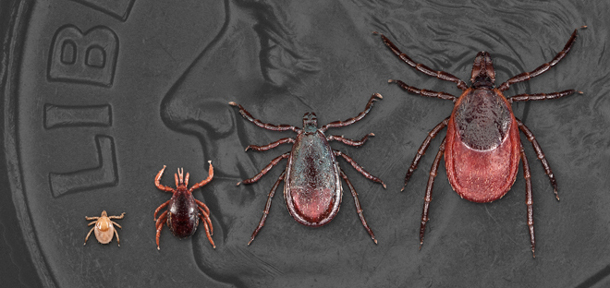
From left, the larvae, nymph, adult male and adult female forms of the blacklegged or deer tick, which can carry Lyme disease. (Photo: CDC)
[GUINEA FOWL CALLING]
DOERING: The Craigslist guineas got right to work.
KOFF: As soon as we started letting them out they were immediately interested in pecking, pecking and pecking. So yeah, they were just sort of tearing up all the bugs! [LAUGHS]
DOERING: Sarah and the kids showed me to a cute little wooden coop with a tin roof, and a single, black and white speckled guinea fowl inside. Sarah unlatched the door and with Hazel’s help, tried to coax the timid bird outside.
[DOOR LATCH SOUND]
KOFF: Hello?
HAZEL: Guinea, you can come out now! What are they doing in there?! [LAUGHS]
DOERING: Is it pretty scared?
KOFF: Well, you know what, they’ve always been scared of us. They’ve always been scared. They’re not, they’re not pets.
HAZEL: Yeah…
KOFF: They’re sort of wild animals that you just have. – There you go.
HAZEL: Ah ha! That’s it.
DOERING: The guinea sprints down the coop’s ramp – and straight into the forest.
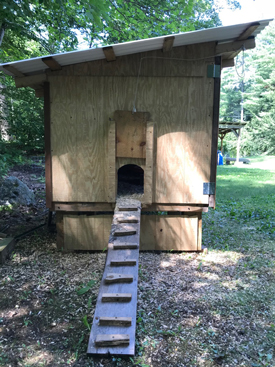
The Koffs’ coop keeps the guinea fowl safe from predators at nighttime, but they’re vulnerable during the daytime when they roam around eating ticks and other bugs. (Photo: Jenni Doering)
KOFF: I don’t think he’ll go very far. He doesn’t usually go very far. Yes, there he is. And we could also give him some scratch. You want to give him some scratch?
[BAG RUSTLING, FEED SPRINKLING ON GROUND]
SUZY: Hey, come on and eat it! You’re not eating it!
DOERING: Why just the one?
KOFF: Well, we used to have eight, but then earlier this week, unfortunately, seven of them disappeared; and we don’t know what happened but we think that they were either killed or ran away; were definitely spooked by some predator, because we did find one dead hen, so... yeah it’s really sad.
[GUINEA CALLING]
DOERING: Finally we spot the elusive guinea in a neighbor’s yard.
KOFF: Oh. There she is, right there, do you see it?
HAZEL: Where is she?
KOFF: Under the bushes.
DOERING: Before the guinea fowl massacre, Sarah says she noticed a dramatic decline in the number of ticks on her family.
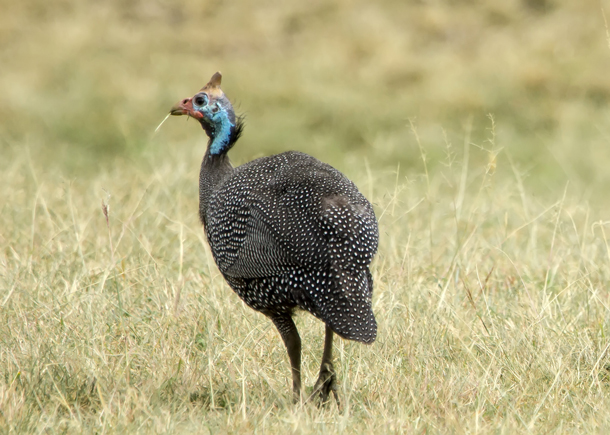
Guinea fowl are native to Africa. Above, a wild guinea fowl in Kenya’s Maasai Mara National Reserve. (Photo: Marc, Flickr, CC BY-NC-ND 2.0)
KOFF: I haven’t seen any ticks on the kids since we’ve let the guineas go roam around. And my husband I think has found one on himself so far.
DOERING: A small 1992 study on Long Island backs up Sarah’s observation.
Researchers placed guinea fowl into tick-infested areas and found that they significantly reduced the adult tick population within the enclosures. But Howard Ginsberg, a research ecologist with the Department of Interior, points out a problem with timing.
GINSBERG: Most people get Lyme disease during June and July when the nymphs are out, and the nymphs are in the woods. The adults, which are the stage that’s targeted by these birds, is out in the fall and spring, out in open areas like people’s lawns; and some people get Lyme disease that way but not most people. So there may be some effect, but in general it’s not going to solve a disease problem.
DOERING: In fact, another study in New York State from 2004 found that where guinea fowl were allowed to range freely, ticks in the nymph stage weren’t reduced, so the Lyme disease risk remained high.
Still, a single female deer tick can lay as many as 2,000 eggs, so removing adult ticks does appear to reduce local Lyme disease risk overall. Fortunately, even if a tick latches on to you, Ginsberg says time is on your side.
GINSBERG: Lyme disease, that bacterium requires something like 24 to 48 hours with tick attachment before it’s transmitted. So if you do a check every day when you get back from the woods and remove ticks, you have eliminated the possibility of Lyme disease fairly substantially.
DOERING: And if you do find a tick embedded in your epidermis…
GINSBERG: The best way to remove a tick is to just take fine tweezers, just grab as close to the skin line as possible, and slowly pull it straight out.
DOERING: Then, take some rubbing alcohol and clean the bite thoroughly.
And get that tick safely out of your life by flushing it down the toilet.
[GUINEA FOWL CALLING]
DOERING: So, does Sarah plan to replenish the flock?
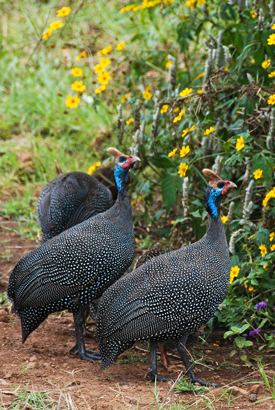
Guinea fowl target adult ticks, not the nymphs, which are more likely to infect a human with Lyme disease. (Photo: Chris.Murphy, Flickr, CC BY-ND 2.0)
KOFF: So we are feeling a little bit unsure of how to proceed with just one right now. They’re very social creatures and they really do need to be with others, and so I’m actually in the middle of deciding whether we bring in some more, maybe some babies, for this one to raise; or do we try to re-home this guinea to a place that has guineas already?
DOERING: No matter what they decide, Sarah says the ticks won’t stop her and the kids from getting outside.
KOFF: Kids need to be just exposed to nature as much as possible and we’re so lucky to be living in a place that – we have the woods right in our backyard; we have a trail that we can connect to from our backyard. There are so many studies that show that it relieves anxiety in kids; it just makes them be more independent, more creative, have a bigger imagination, and just more comfortable in the outdoors, which is -- I mean, it’s therapy. But I also just check them for ticks every day and I try not to be anxious about it, because there’s not too much I can do about it other than check them thoroughly.
DOERING: With a thorough head-to-toe check, even the smallest ticks can be found before they pose a Lyme disease risk. For Living on Earth, I’m Jenni Doering in Exeter, New Hampshire.
[GUINEA FOWL CALLING]
Related links:
- 1992 study about guinea fowl reducing adult deer tick
- 2004 study that found guinea fowl do not reduce tick nymphs
- Lyme disease and climate change
- CDC on how to remove a tick
- CDC information on tickborne diseases
[BIRDNOTE THEME]
BirdNote®: Do Birds Use Ants as Tools?
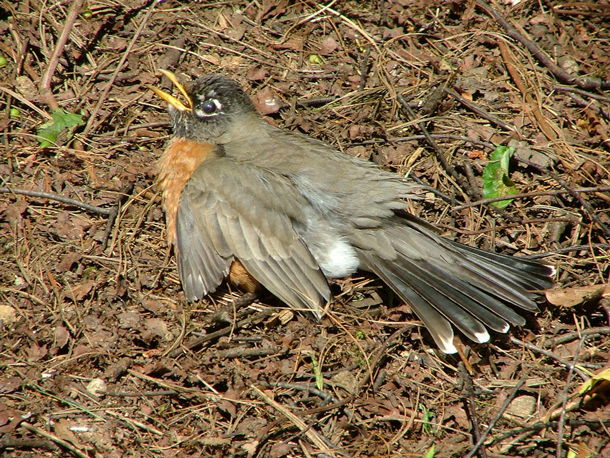
An American Robin spreads its wings and engages in “anting” behavior. (Photo: © John Dennehy)
BASCOMB: Now, guinea fowl have a reputation for being pretty dumb -- bird brained, you might say. But some birds are far smarter than you might expect. Take the common American Robin, which has learned to use an unusual tool for personal hygiene. BirdNote®’s Michael Stein has more.
BirdNote®
Do Birds Use Ants as Tools?
[American Robin song]
It’s a warm, sunny day, and we’re watching an American Robin, sitting on the ground, its wings outstretched and its tail splayed out behind it. If you look more closely, you might see something a bit shocking.
The robin is sitting on top of an anthill, and ants are swarming all over its body! You might even see the robin take an ant in its bill and wipe it underneath its wings.
So, what’s happening? Well, it’s kind of like an avian spa treatment.
[American Robin song]
Ornithologists call it “anting.” Although you might not see it too often, more than 250 species of birds have been recorded doing it. The purpose of anting remains something of a mystery, although most experts agree it has to do with transferring the ants’ secretions to the bird’s body. It’s likely that the ants’ formic acid helps the bird control feather-mites and other parasites. Some birds have been seen using citrus fruits, mothballs, and even glowing embers to achieve the same effects. One clever bird, a rook — the British cousin of the American Crow — even learned to strike a match, then touch the hot tip under its wing! * Talk about a hot spa treatment. [rook sound]
I’m Michael Stein.
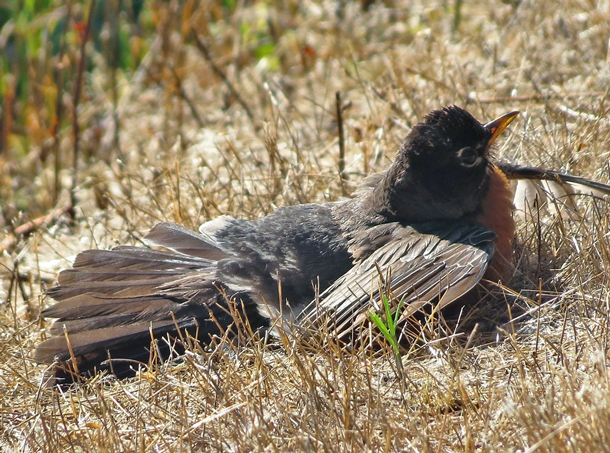
Anting is a way for the American Robin and hundreds of other bird species to control feather mites and other parasites. (Photo: © Mike Hamilton)
Written by Bob Sundstrom
Producer: John Kessler
Managing Producer: Jason Saul
Editor: Ashley Ahearn
Associate Producer: Ellen Blackstone
Assistant Producer: Mark Bramhill
Narrator: Michael Stein
Bird sounds provided by The Macaulay Library at the Cornell Lab of Ornithology, Ithaca, New York. Recorded by G. A. Keller. Ambient recorded by C. Peterson.
BirdNote’s theme composed and played by Nancy Rumbel and John Kessler.
© 2019 Tune In to Nature.org June 2012 / July 2019 Narrator: Michael Stein
ID#063006AMROKPLU anting-01c
* Reference noted: Dennis, John V. Beyond the Bird Feeder. New York: Alfred A. Knopf, 1981. 1981:83
“Audubon's Original Notes on the Habits of the Wild Turkey Written for Charles Lucien Bonaparte” by A. W. Schorger. The Auk Vol. 79, No. 3 (Jul., 1962), pp. 444-452 (9 pages). DOI: 10.2307/4082826 https://www.jstor.org/stable/4082826
Morozov, Nicholai. (2015). Why do birds practice anting? Biology Bulletin Reviews. 5. 353-365. 10.1134/S2079086415040076. https://www.researchgate.net/publication/282623092_Why_do_birds_practice...
https://www.birdnote.org/show/do-birds-use-ants-tools
BASCOMB: For pictures, flit on over to our website, loe dot org.
Related links:
- BirdNote®: “Do Birds Use Ants as Tools?”
- Watch a video of an American Robin exhibiting “anting” behavior
- All About Birds: Learn more about the American Robin
[MUSIC: Eric Clapton, “Change The World” on Platin - The Very Best Of Vol. 2, Warner Special Marketing GmbH]
BASCOMB: Living on Earth is produced by the World Media Foundation. Our crew includes Naomi Arenberg, Diego Arenas, Paloma Beltran, Thurston Briscoe, Jenni Doering, Jay Feinstein, Merlin Haxhiymeri, Don Lyman, Lizz Malloy, Aynsley O’Neill, Jake Rego, and Jolanda Omari. Tom Tiger engineered our show. Alison Lirish Dean composed our themes. Steve Curwood is our Executive Producer. You can hear us anytime at L-O-E dot org, iTunes and Google play- and like us, please, on our Facebook page - PRI’s Living on Earth. We tweet from @livingonearth. And find us on Instagram @livingonearthradio. I’m Bobby Bascomb. Thanks for listening!
ANNOUNCER: Funding for Living on Earth comes from you, our listeners, and from the University of Massachusetts, Boston, in association with its School for the Environment, developing the next generation of environmental leaders. And from the Grantham Foundation for the protection of the environment, supporting strategic communications and collaboration in solving the world’s most pressing environmental problems. Support also comes from the Energy Foundation, serving the public interest by helping to build a strong, clean, energy economy.
ANNOUNCER 2: PRI, Public Radio International.
Living on Earth wants to hear from you!
Living on Earth
62 Calef Highway, Suite 212
Lee, NH 03861
Telephone: 617-287-4121
E-mail: comments@loe.org
Newsletter [Click here]
Donate to Living on Earth!
Living on Earth is an independent media program and relies entirely on contributions from listeners and institutions supporting public service. Please donate now to preserve an independent environmental voice.
NewsletterLiving on Earth offers a weekly delivery of the show's rundown to your mailbox. Sign up for our newsletter today!
 Sailors For The Sea: Be the change you want to sea.
Sailors For The Sea: Be the change you want to sea.
 The Grantham Foundation for the Protection of the Environment: Committed to protecting and improving the health of the global environment.
The Grantham Foundation for the Protection of the Environment: Committed to protecting and improving the health of the global environment.
 Contribute to Living on Earth and receive, as our gift to you, an archival print of one of Mark Seth Lender's extraordinary wildlife photographs. Follow the link to see Mark's current collection of photographs.
Contribute to Living on Earth and receive, as our gift to you, an archival print of one of Mark Seth Lender's extraordinary wildlife photographs. Follow the link to see Mark's current collection of photographs.
 Buy a signed copy of Mark Seth Lender's book Smeagull the Seagull & support Living on Earth
Buy a signed copy of Mark Seth Lender's book Smeagull the Seagull & support Living on Earth

